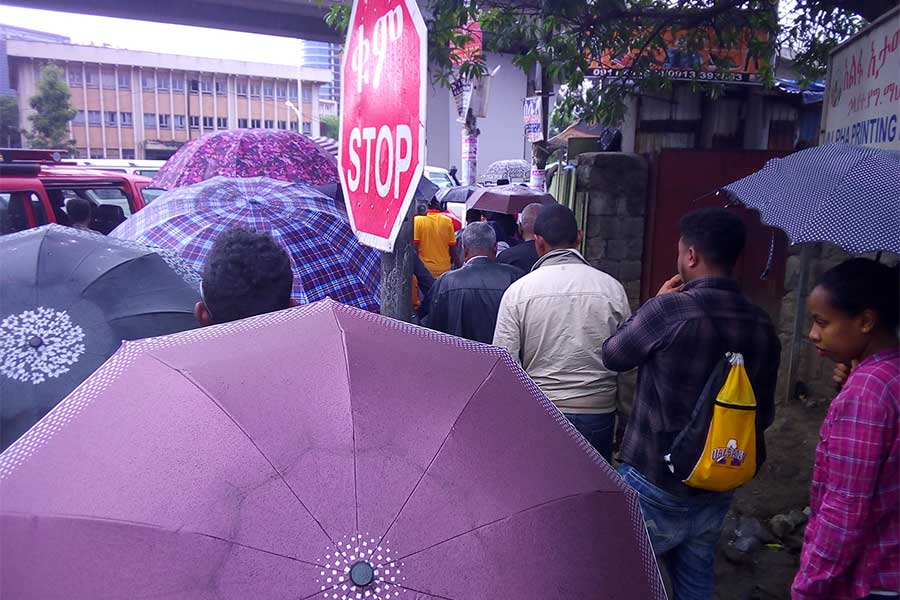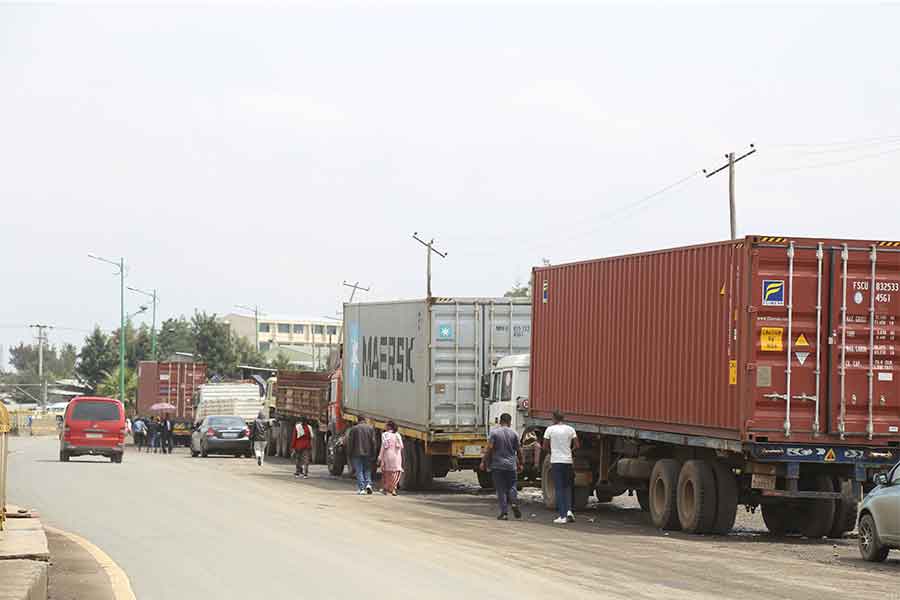
If someone was to visit the huts located in Amibara Wereda at night during the rainy season, that person would find themselves occupied with mostly women and children. The men and young boys, who live in this Weredalocated in Afar Regional State, spend their nights dozing off next to canals lining the Awash River that flows by the neighbourhood.
Every year, the men stand guard as the rainy season raises the water level of the River that flows through the neighbourhood. It is imperative that they stay vigilant and pile on sand-filled sacks to stop the River from overflowing.
"That's what comes with living here," said Tesfalem Bekele, whose home was submerged along with close to 145,000 others who live in the Regional State. "We were standing guard this year when it happened."
But while Tesfalem and the neighbourhood had their eye out for the water by the canals, it had sneaked into the saturated ground and erupted hundreds of metres away right in the middle of their homes. The Weredawas flooded and people had to scramble for their lives in the dead of the night.
Tesfalem and his extended family used to work on four hectares of land where they grew vegetables, siphoning water from a neighbouring investor's land.
"The man had over 6,000ha, so he helped us out with irrigating our land," said Tesfalem. "We also work on his farm."
This is true for him and many others who make their living by providing their labour and working on big sugarcane farms where they earn 17 Br to 34 Br a day. But the flood has also robbed them of this since it has destroyed 59,000ha of farming land in its wake. They woke up one day to find themselves without jobs or homes.
"We left with the clothes on our back," said the 22-year-old who has now been placed in temporary housing in the area. Tesfalem, along with his parents and four other siblings are now living with 600 other households in the vacant houses located a few kilometres away. These houses are one of the 47 campsites located in the region. Though help has come from different sources, it has been far from enough.
The National Disaster & Risk Management Commission, responsible for coordinating responses in times of emergency, has been one of the responders. Following a warning earlier in August by the National Meteorological Agency, which predicted unusually heavy and continuous rainfall across the country, it crafted a Flood Emergency Response Plan.
With 17 of the 34 weredasin dire need of humanitarian assistance, necessary items like food and non-food items essential for survival such as wheat, oil, dates and other items like blankets, cups, plates, and cooking pots were the first to be dispatched. The floods had spared no region, and help was first sent to highly impacted areas in Oromia, Afar, Gambella and Somalia regional states. But it has yet to make its way to many campsites.
At campsites in Amibara, the rations of food may be small, but there is also nothing to cook it with. Abiye Abdu is a community representative in charge of receiving and distributing supplies to the 680 households in the campsite there. He spends most of the day in front of the door to the supply room chewing khatwith a few others.
"There's some clothes and other items in there," he said, pointing to the gap in the door which revealed sacks filled with donated clothes. "But we haven't been told to distribute it."
Kochera School has now been turned into one of the 47 temporary campsites in Afar Regional State housing people that have been displaced due to the floods.
Abiye is not sure what they are waiting for to distribute the supplies.
The donations include the latest batch of sanitiser and soap that came with a visit of officials a few days ago, including the Minister of Water, Irrigation & Energy, Seleshi Bekele. The donations were intended for use to curb the spread of the Novel Coronavirus (COVID-19).
The items are just sitting in the house, but even their distribution is not something to look forward to, according to Abiye.
"We need food and water," he said. "What're we going to do with sanitiser?"
The Flood Response Plan crafted by the Commission has estimated that close to half a million people have food assistance, but over half a million more new beneficiaries are anticipated.
It is not just a shortage of food supplies but accessibility to the flooded areas that have remained a challenge. Some have been totally barricaded by water, and others are half submerged.
The one asphalt road leading to Asaita, another badly hit wereda, from the region's capital of Semera has been swallowed by the rising water from the banks. From one submerged end to another lies half a kilometre of thigh-deep water that most of the community wades through with clothes hiked up from the dirty water below. The minibuses, however, all stop here. Their proximity to the ground does not allow them to drive through without sinking their exhaust pipes.
Only bigger pick-ups and four-wheel drive vehicles along with the bravest three-wheeled bajajs make that journey. Even then, many bajaj drivers stop midway to get off and feel the ground with their feet first, lest their small vehicles veer of course.
It's across this barricade that you find Asaita, where many campsites are located at schools that have been closed due to the pandemic. But the flooding crisis had defeated the purpose of the school closures now that a classroom houses up to seven families.
Amina Yasin lives in one of these classrooms with six other families. There are a few mattresses in her room, and a small child is fast asleep on a piece of clothing stretched, banana-hammock style, from two ends of a metal bar that used to be a desk in the classroom.
She lost her four goats and her farmland to the floods that had encircled their land.
"We were taken out by a helicopter," said the mother of seven. "There was no way to leave our houses as the water was quick."
She is happy they are getting food for now, but she worries about how she will take care of her family after the rainy season passes.
"I don't know how I can restart my life with nothing," she said.
This is a concern for many in the region whose livelihoods depended on raising cattle. The floods have caused the destruction of 21,000 sheep, goats and camels in the region, according to Mohammad Husen, director of the Afar Disaster Prevention & Food Security Coordination Office.
"There is a recovery and rehabilitation plan underway," he said, "and this involves restocking families with cattle and facilitating a permanent home."
This will be implemented in a three to six-month plan that will also include mending parts of the 300Km of damaged roads in the region.
Though the region is not the only one that is reeling from the effects of the floods, with over a million people displaced across five more regions in Amhara, Gambella, Oromia, Somalia, Southern Nations Nationalities & People's and the two administrative zones of Dire Dawa and Addis Abeba, the impact here has been much worse. The floods have affected nearly as many people this year as the last 10 years combined.
"This is rainfall that we haven't seen in over 30 years," said Mohamed. "It is beyond our capacity to address it, so we had to request support from the Federal government."
The first element of the intervention has been immediate search and rescue efforts. The regional Bureau has all the names and lists of the displaced people, according to Mohamed, who says that the report shows no lives have been lost.
But the lists themselves are made up of people that have already been relocated. The worry of many at the campsites is that there may be countless numbers of people unaccounted for.
"We weren't relocated together," said Hassen Ahmed, who lives in a campsite in Amibara. "We can't tell who has been rescued and who hasn't. We've been separated."
His community lives in the inaccessible area of Amibara in Zone 03 where a boat trip is required. This area has been marked as a priority zone by UNICEF, a partnering organisation in relief for flood-affected areas.
Supplies of buckets, water treatment kits, storage tanks and jerrycans have been dispatched at a cost of 50,000 dollars to Amibara and five other weredas. The organisation expects to receive an additional 70,000 dollars for rehabilitating and maintaining damaged and non-functional water schemes from the UN’s Central Emergency Relief Fund.
Providing high energy biscuits and dignity kits for flood-affected women and adolescent girls have been underway, but gaps still exist in water and non-food item provisions among others, according to the organisations assessment.
The campsites tell the same story. There is no electricity at all at some sites, and residents have to line up at charging stations kilometres away to get their phones working. A widespread shortage of cooking utensils, like pans and pots, is another difficulty, all hastily left behind along with all other worldly possessions. The river water, mixed with water released from the nearby dams, has also been a source of skin and health problems for many that use it to wash their bodies and clothes. Some even say they have seen dead bodies in the River.
Ill preparation may be one of the culprits for this crisis, as floods of this nature seldom occur, according to Muluneh Woldetsadik (PhD), an expert in geography and environment.
"The topography of the affected areas is another factor," said Muluneh, "as it is a lowland area that collects all the water that has nowhere else to go."
But the intensity of the rainfall this year is also undeniably high, according to the expert.
"The amount of rainfall dropping within a short amount of time is quite high, and that has affected the water retention capabilities of the ground," he said.
Resettlement of people living in these high-risk areas is one approach to ensure future risk mitigation, and working on dikes and water canals that can help minimise the impact of floods should also be done in a very critical manner, he recommended.
Tesfalem also shares this idea.
The bulldozers in Amibara working to close off the river and return it to its right track only appear once the rain starts to drop, according to Tesfalem.
"Flood risks are not new to us. It happens every year," he said. "But every year the government comes a little too late."
PUBLISHED ON
Sep 19,2020 [ VOL
21 , NO
1064]

Sunday with Eden | Jul 10,2021

Sunday with Eden | Feb 23,2019

Radar | Dec 17,2022

Sunday with Eden | Apr 11,2020

Radar | Dec 28,2019

Radar | Jul 25,2020

Radar | Dec 10,2022

Fortune News | Jul 13,2019

Editorial | Jul 24,2021

Fortune News | Jun 08,2019

Dec 22 , 2024 . By TIZITA SHEWAFERAW
Charged with transforming colossal state-owned enterprises into modern and competitiv...

Aug 18 , 2024 . By AKSAH ITALO
Although predictable Yonas Zerihun's job in the ride-hailing service is not immune to...

Jul 28 , 2024 . By TIZITA SHEWAFERAW
Unhabitual, perhaps too many, Samuel Gebreyohannes, 38, used to occasionally enjoy a couple of beers at breakfast. However, he recently swit...

Jul 13 , 2024 . By AKSAH ITALO
Investors who rely on tractors, trucks, and field vehicles for commuting, transporting commodities, and f...

Jun 28 , 2025
Meseret Damtie, the assertive auditor general, has never been shy about naming names...

Jun 21 , 2025
A well-worn adage says, “Budget is not destiny, but it is direction.” Examining t...

Jun 14 , 2025
Yet again, the Horn of Africa is bracing for trouble. A region already frayed by wars...

Jun 7 , 2025
Few promises shine brighter in Addis Abeba than the pledge of a roof for every family...